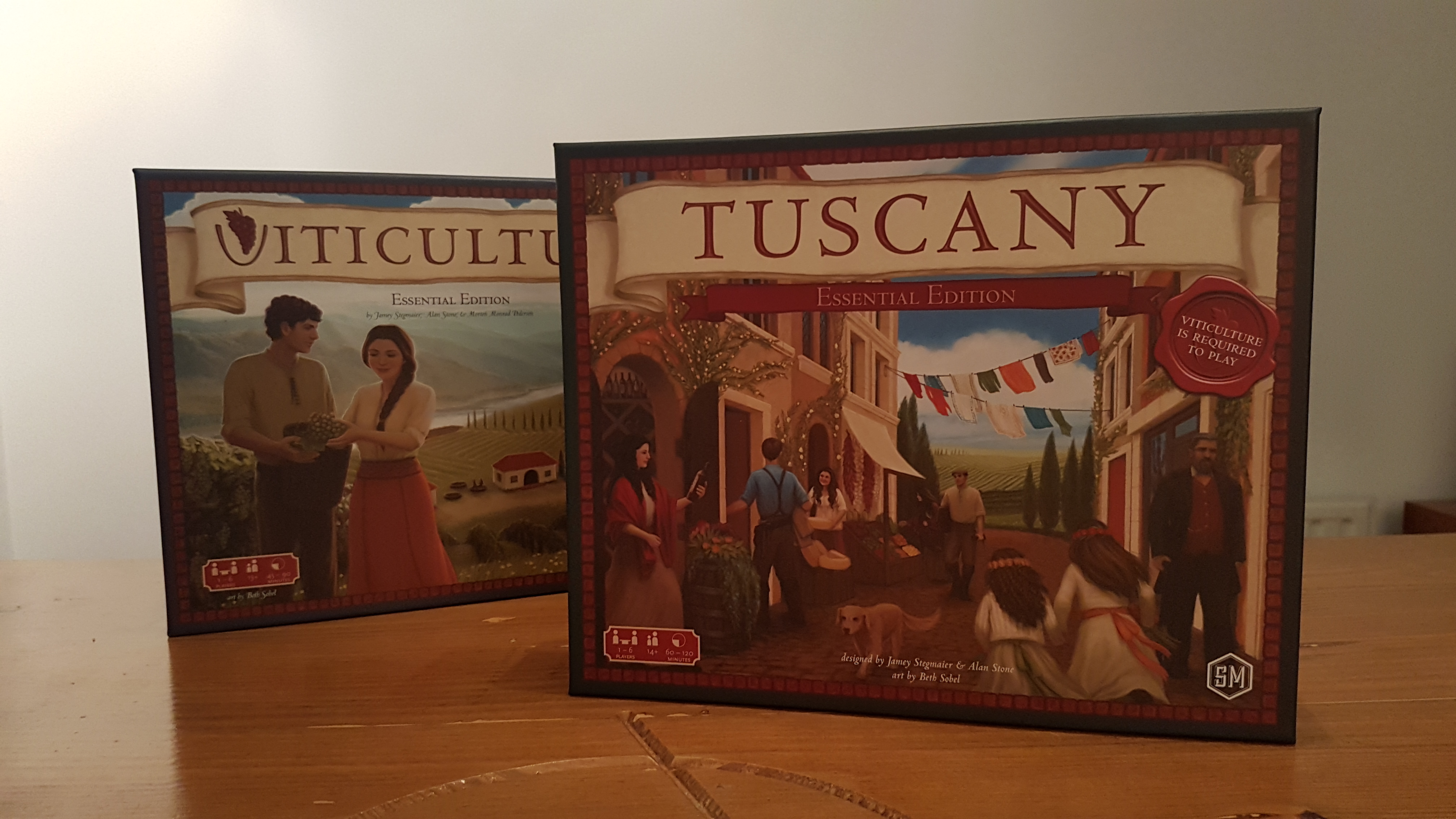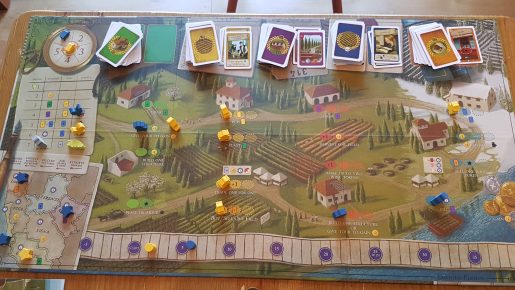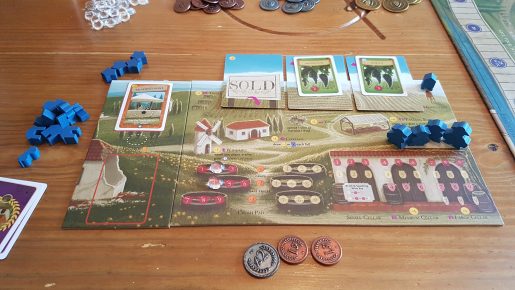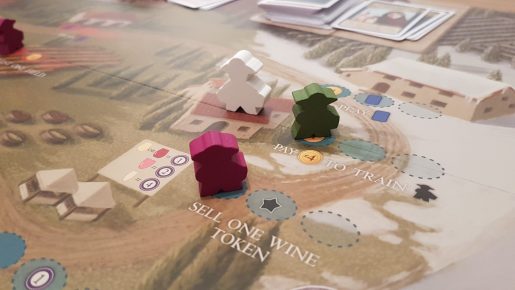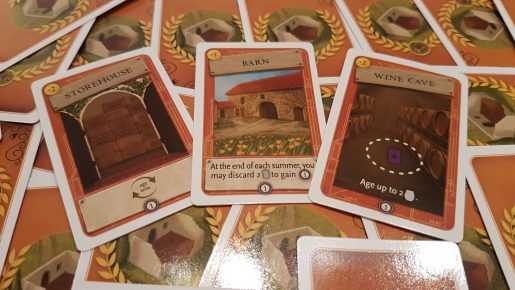Tuscany Essential Edition is a version of the first expansion for Viticulture, the famed wine making worker placement title from Stonemaier Games. Designed by Jamey Stegmaier and Alan Stone, this expansion features a new game board to play on, a brand new card type and special workers. Each element hopes to take your wine business to the next level. However, is this highly regarded expansion really something to “wine” about not having? Let’s find out!
Three different elements are added into the Viticulture experience by the Tuscany expansion. Rather than railroading all content in, players can step themselves into the new content, or choose to only include their favourite element. Stonemaier Games clearly has taken this seriously by including a double sided board. The board itself is the one module of the Tuscany expansion, with one side featuring a space for the new orange structure cards and the other not.
Shaking up the way the wake up chart works, changing to four individual seasons and introduction an area control style map section, it is fair to say the board has changed. To accommodate the new content the board has also seen a size increase, making it easier to see the beautiful artwork but further to stretch across. The new wake up chart has a few interesting elements. Players are no longer guaranteed a visitor card in fall. Instead, each wake up row has a benefit for the player as they pass into each new season. Some rows will give cards while others will not.
Take the last wake up position as an example. Aftering passing the Spring action, before moving into Summer the player will slide their cockerel across and take the grey bonus worker meeple. After passing in Summer the cockerel is then slide into the fall column where the player can take any card type. After passing in Fall the player takes the grape token from the wake up track. Unlike in the base game the grape token means you’ll be in slot one of the wake up order in the next year. Alas, you get no seasonal bonuses at all when on the first row. Wake up order is now chosen as part of the year clean up, still in order. This is balanced by lower rows being more beneficial – with one space even ageing grapes!
Splitting into four seasons the game surprisingly doesn’t lose the flow it had with only two. Due to a slight rejig and additions, each season has actions players will want to take throughout the game, rather than how summer slowly became less useful in base Viticulture. Build a structure and give a tour can still both be done in spring, yet in summer there is now an action space where players can do either of these two actions. This is needed when including the orange structure cards to help the game flow. Though, it also opens up more opportunities to give a tour each year – increasing the potential benefit from owning a tasting room. Players still can only get 1VP a year from tasting room tours, so this isn’t the OP strategy I thought it might be…
This extended board fixes two major issues with the base game, wine selling and the lack of bonuses in 2 player games. The latter was an easy fix with some of the first action spaces, the only ones available in 2 player games, now featuring bonuses. This was something that made 2 player games feel like they were missing something and even slowed the experience down in the base game.
Viticulture still has luck of the draw, still with Tuscany the luck of wine order cards has been reduced. Outside of wine orders players can sell wine in winter for victory points. These action space takes into account only the type of wine, disregarding value. It offers 1VP for a red/white wine, 2VP for a blush wine and 3VP for a sparkling wine. This minor change allows players to gain points without holding specific wine orders in their hands from the offset of the game. You will get a better return from completing a wine order, due to the yearly income, but additional options are most welcome. Also, due to some of the new structures, the wake up chart tweaks and the bonuses, more wine order cards seemed to be churned through.
The area control element added in by the new board is small but not underwhelming. A few action spaces offer the opportunity to add or move a star, identical in style and shape to those used in Scythe, to an area on the map. Areas have both an instant benefit of Lira or cards and an end of game benefit of victory points. After placing six stars down players can then only move them around, and this can be key to victory. Having the most in an area, thus control, after the game has ended scores the player the victory points denoted on the board. This can see someone come from behind to win if their opponents have completely neglected the map, something highly unlikely given the instant benefits.
Orange structure cards are the next module, adding in a small player board extension, which can house two built structures. It is also possible to build a structure on an empty field – making it a harder decision to sell a field early on. There are 3 types of structure cards split by their benefit type: action, enhancement and residual. Each have their own benefit, and like the visitor cards the strength of individual cards is situational. Action structures unsurprisingly add a unique action space to that players board, that is for their personal use only. Enhancements are ongoing buffs, such as the ability to plant grape vines without the necessary structures. The final type, residual, adds to the money you earn at the end of each year from the residual payment tracker – seeing players gain cards or even victory points each year.
On the additional personal side boards is a new action space to destroy a constructed structure. This can be vital if you get a building down early on that helps get your engine going or reduces the cost of other structures. These can start to become useless later on in the game, so being able to replace them with something more beneficial makes the decision to build them easier. While it might have been interesting to see how the dynamic would be different if you couldn’t destroy structures, a lot less would be used as a result. On top of this, it is noteworthy that you gain a victory point whenever a orange structure card is built, so it can also help you just cross the higher 25 point finish line.
The complexity has been minutely bumped up from that of the base game. Mostly this is from having more to think about, rather than the new mechanics being hard to get your head around though. The element that adds the most is the third module, special workers. Each game only 2 of the 11 included special workers will be in play, drawn randomly from the deck. This is done during setup, before players choose their Mama and Papa cards. Included in the box are 14 special worker meeples, split into two designs in 7 colours – the six available player colours and grey. The grey meeples are placed on the special worker cards to distinguish which special worker design is for which during that game.
Costing only an additional Lira when taking the train worker actions, the 11 special worker types offer a unique ability that you may use or may be triggered. For example, the Chef can bump an opponent’s normal worker back to them to go on an action space, while the Soldato opens up an action to all, even if all action spaces are taken – however opponents must pay the player 1 Lira to go there. The latter I’ve found best, alongside the Innkeeper as suggested by the rules, to shuffle back in and redraw in a two player game as it’s otherwise slightly underwhelming.
There are some limitations to keep the gameplay tight. Players are still restricted to only 6 workers in total and players can only train one of each type of special worker. To date I haven’t seen a game where a single player didn’t see the benefit of training at least one special worker, though some will be a little more situational and may not always perfectly blend with your strategy. The merchant for example gains the player a card if placed in a season after all others have passed. If you don’t need more cards or want to save meeples for later the strength of the power is significantly reduced. These special workers do add a new wave of replayability into the title, as it is interesting to see how each power can slightly tweak they optimal way to play.
Viticulture Essential Edition isn’t exactly a short game and that doesn’t change with Tuscany Essential Edition. While the play time doesn’t drastically change, once up to speed with the additional rules and content, on average it seems to be add approximately 15 minutes. For a game already potentially lasting 2 hours this is an insignificant increase, and one which I wouldn’t have noticed if it hadn’t been for a timer. It is worth noting that your first game with Tuscany included will be a good 30 minutes longer. This is unsurprising given the number of changes. Players will have to re-learn the balance of what things are worth, alongside getting to grips with the new area control mechanics, worker types and structures.
Overall, while to me the workers confuse things slightly, they do offer an extra amount of replayability that’ll see then deployed occasionally. Conversely, the changed board is a must for any Viticulture fan, mostly for the balance it brings from selling wine. Structures are not without a hint of luck, with top drawing great cards possible, but they build upon the systems of a great game. Each module feels like it belongs in the game of Viticulture, something every expansion should strive for. For once, I’ve found the claims of brilliance to be spot on, and not just hype, to the extent I’d struggle to go back to just the base game.
[Editor’s Note: Tuscany Essential Edition was provided to us by Asmodee UK for review purposes. The game is currently available on 365 Games for £25.99. It is also available from local UK board game stores, find your local store here]

